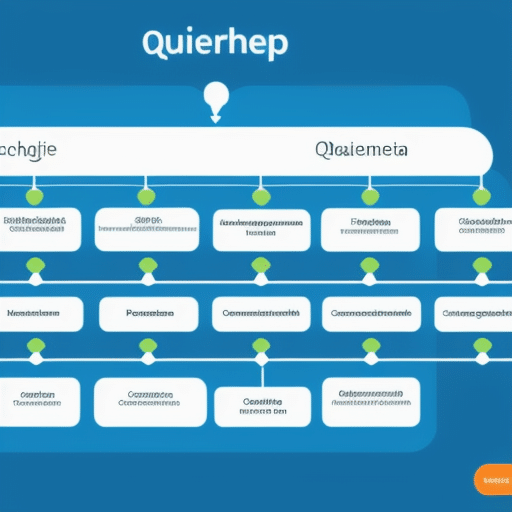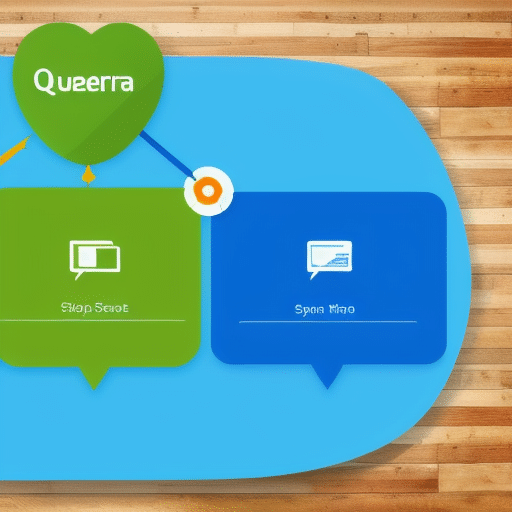A sitemap is a vital tool for any website wishing to improve its search engine ranking.
Essentially, a sitemap is an XML file that contains a list of all the pages in a site. web site.
This allows search engines to crawl and better understand the structure of the site, which in turn improves the indexing and ranking of the site in search results.
In this article, we will explore what is a sitemap and why it is important to have on your website.
We will also discuss the different types of sitemaps available, the tools to create them effortlessly and how to avoid common mistakes when creating them.
We will also show you how to keep your sitemap updated to ensure proper indexing of your pages.
What is a sitemap and why is it important to have it on your website?
A sitemap is a file that contains a list of all the pages of a website and their hierarchical organization.
Its main function is to help search engines find all the pages of the website and understand their structure, which facilitates the indexing of the pages in search results.
It is important to have a sitemap on your website because it helps improve SEO rankings by ensuring that all pages are indexed correctly and that content is displayed in relevant search results.
In addition, the use of a sitemap can also improve the user experience by allowing easier and clearer navigation of the website.
A sitemap can be created in different formats, such as XML or HTML, and can contain additional information, such as how often pages are updated and their relative importance on the website.
It is advisable to have a sitemap updated whenever new pages are added or changes are made to the structure of the website to ensure that search engines have access to all relevant information.
In summary, a sitemap is a fundamental tool to improve the visibility and positioning of a website in search results, as well as to provide a clear and organized navigation for users.
Types of sitemaps: which one is the most suitable for your website?
There are different types of sitemaps that you can use on your website, but which one is the most suitable for you? Before answering this question, it is important to know that a sitemap is a tool that helps search engines index and understand the structure of your website.
The type of sitemap you choose will depend on the type of website you have and the content you want to highlight.
One of the most common types of sitemaps is XML, which is a file containing a list of all the pages of your website.
This type of sitemap is ideal for large websites with many pages and subpages, as it helps search engines find all content more efficiently.
Another type of sitemap is the HTML sitemap, which is a web page specifically designed to show the structure and content of the website.
This type of sitemap is more suitable for small to medium sized websites with fewer pages and content.
There is also the video sitemap, which is used for websites with audiovisual content such as videos or animations.
This type of sitemap helps search engines to better understand multimedia content and can improve the visibility of the website in search results.
Finally, there is the image sitemap, which is used for websites with a large number of images.
This type of sitemap helps search engines better understand visual content and can improve website visibility in image-related search results.
In summary, the type of sitemap you choose will depend on the type and size of your website, as well as the content you want to highlight.
It is important to choose the right type to ensure that search engines can correctly index all content and improve the SEO ranking of the website.
Tools to create a sitemap effortlessly
Creating a sitemap can be a tedious and time-consuming task, especially if your website has many pages.
Fortunately, there are tools to create a sitemap effortlessly that will help you save time and avoid errors.
One of the most popular tools for creating a sitemap is XML Sitemap Generator.
This tool is free and easy to use.
Simply enter the URL of your website and select the configuration options you want, such as update frequency and page priority.
Then click on "Generate sitemap" and download the XML file.
Another useful tool is Screaming Frog SEO Spider.
This tool not only creates a sitemap, but also performs a complete analysis of the website for errors and technical problems.
The free version has some limitations, but the paid version offers more functionalities.
If you prefer an online tool, you can try Online XML Sitemap Generator.
This tool allows you to create a sitemap for websites with up to 500 pages for free.
It also offers advanced options such as the inclusion of images and hreflang tags.
In summary, there are several tools available to create a sitemap effortlessly and save time.
When using these tools, be sure to follow the best practices for creating an effective sitemap to improve your website's SEO ranking.
Steps to generate a sitemap and how to include it in your website
Generating a sitemap is a fundamental task to improve the SEO positioning of your website.
To do so, follow the steps below:
First of all, you need to be clear about the structure of your website.
You must know how many pages it has and how they are organized.
Once you have this information, you can generate the sitemap using specific tools for this purpose.
A widely used option to create a sitemap is through Google Search Console.
If you don't have an account yet, register on the platform and verify your website.
Then, go to the "Sitemaps" section and add the URL of the sitemap you created.
Google will be in charge of crawling the pages included in it
Another option to generate a sitemap is to use tools such as XML Sitemap Generator or Slickplan.
These tools allow you to create the XML file with all the pages of your website automatically.
Once you have generated the sitemap, it is important that you include it on your website so that search engines can easily find it.
To do this, you must add the URL of the sitemap in the robots file.txt file of your website.
This file is located at the root of the domain and is responsible for telling search engines which pages may or may not be indexed.
By following these steps you can effectively generate a sitemap and ensure that all pages of your website are being indexed correctly by search engines.
Common mistakes when creating a sitemap and how to avoid them
When creating a sitemap, it is common to make some mistakes that can affect the indexing of your website pages.
One of the most common mistakes is to include pages in the sitemap that should not be there, such as duplicate pages, login pages or 404 error pages.
To avoid this error, it is important to carefully review each page before including it in the sitemap and make sure it is relevant and active.
Another common mistake is not updating the sitemap regularly.
If you add new pages to your website or delete some, it is important to update your sitemap to ensure that all relevant pages are included and can be indexed correctly.
Also, if you have a large website with many pages, splitting the sitemap into several sections can help ensure proper indexing.
It is also important to avoid including pages blocked by robots.txt in the sitemap.
If a page is blocked by robots.txt, it means that you do not want search engines to index it.
Therefore, including it in the sitemap will only confuse search engines and may negatively affect your SEO ranking.
In summary, when creating a sitemap, it is important to carefully review each page before including it, update it regularly and avoid including irrelevant pages or pages blocked by robots.txt.
By avoiding these common mistakes, you can ensure that all relevant pages are indexed correctly and improve your website's SEO ranking.
Benefits of having a sitemap on your website to improve your SEO ranking
A sitemap is a very useful tool to improve the SEO positioning of a website.
By having a sitemap, search engines can crawl and find all the pages of a website more efficiently.
This means that all pages will be indexed in search results, which will increase the visibility of the website and attract more organic traffic.
In addition, a sitemap also helps to improve the user experience.
By having a clear and easy-to-follow structure, visitors can quickly find what they are looking for.
This reduces the bounce rate and increases the time users spend on the website, which in turn improves the website's reputation with search engines.
Another important benefit of having a sitemap is that it allows website owners to identify pages that need improvement in terms of SEO.
By reviewing the sitemap, you can identify pages that are not being indexed or are not receiving enough traffic.
This allows owners to take steps to improve these pages and increase their visibility in search results.
In summary, having a sitemap is an effective strategy to improve the SEO positioning of a website and attract more organic traffic.
In addition, it also helps improve the user experience and allows owners to identify areas that need improvement in terms of SEO.
Therefore, it is a valuable tool for any website owner looking to improve their online presence.
How to keep your sitemap updated to ensure proper indexing of your pages
Keeping your sitemap updated is essential to ensure the correct indexing of your pages in search engines.
To do so, it is important that you follow certain steps to keep it up to date.
First of all, you must update your sitemap every time you add or remove a page from your website.
You should also periodically check for broken links or inaccessible pages that need to be removed.
It is also advisable to include "lastmod" tags in each URL of your sitemap to indicate the last modification date of each page and help search engines understand which content is new or updated.
Another important aspect is the frequency with which you update your sitemap.
If your website changes frequently, you should ideally update the sitemap on a daily or weekly basis.
On the other hand, if your website has less frequent changes, you can choose to update the sitemap on a monthly basis.
There are tools like Google Search Console that allow you to automatically submit and update your sitemap, which can save you time and effort.
However, it is important that you always verify that the information is correct and up to date.
In short, keeping your sitemap up to date is key to ensuring that search engines can find and index all the pages of your website correctly.
By following these steps and periodically reviewing your sitemap, you can improve the SEO positioning of your website and increase its online visibility.
In summary, a sitemap is an important tool to improve the user experience and SEO positioning of your website.
With the different types of sitemaps available and the tools to create them easily, there is no excuse for not having one on your website.
In addition, it is important to keep it updated to ensure proper indexing of your pages.
However, despite its importance, mistakes are often made when creating a sitemap.
It is important to avoid these mistakes to ensure that the sitemap performs its function correctly.
Reflecting on this, we can ask ourselves what other tools or strategies can we use to improve the SEO positioning of our website? How can we stay on top of the latest trends and changes in search engine algorithms to adapt our strategy? The constant search for new ways to improve website performance is essential in the ever-evolving digital world.




